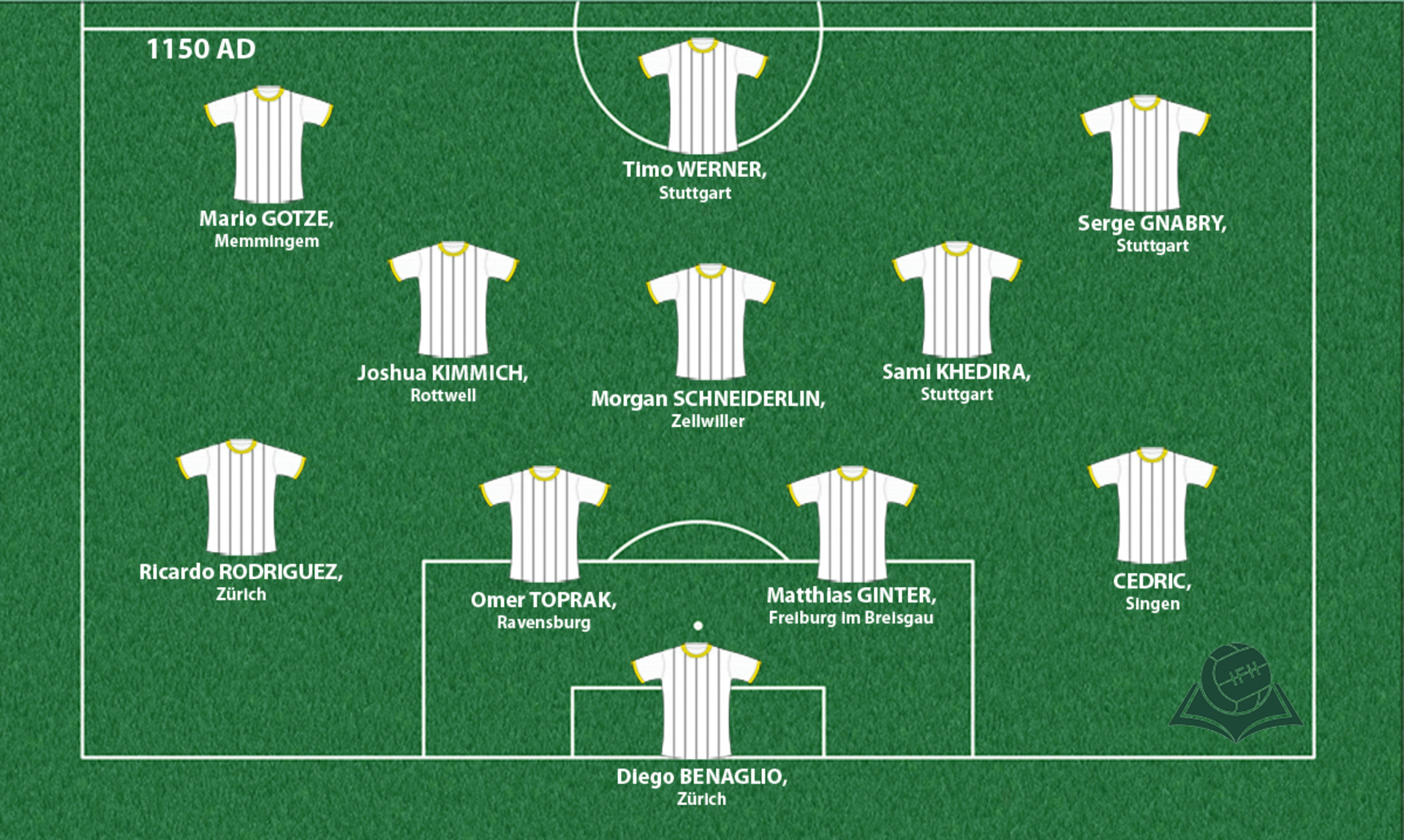The Duchy of Swabia
Duchy of Swabia was one of the stem duchies within Holy Roman Empire, whose inhabitants interchangeably were called Alemanni or Suebi. It was stretched from the Alsatian Vosges mountain range in the west to the right bank of the river Lech in the east and up to Chiavenna and Gotthard Pass in the south.

Coat of arms

Shirt
| Position | First name | Last name | Mjesto rođenja | Like | Dislike | |
|---|---|---|---|---|---|---|
| GK | Diego | BENAGLIO | Zürich |
4 |
0 |
|
| GK | Loris | KARIUS | Biberach |
2 |
2 |
|
| GK | Oliver | BAUMANN | Breisach am Rhein |
2 |
1 |
|
| DC | Fabian | SCHAR | Wil |
1 |
0 |
|
| DC | Matthias | GINTER | Freiburg im Breisgau |
3 |
0 |
|
| DC | Ömer | TOPRAK | Ravensburg |
5 |
0 |
|
| DC | Timo | BAUMGARTL | Böblingen |
3 |
0 |
|
| DRC | Manuel | AKANJI | Wiesendangen |
4 |
1 |
|
| DRC | Nico | ELVEDI | Zürich |
2 |
0 |
|
| DRC | Serdar | TASCI | Esslingen am Neckar |
1 |
1 |
|
| DLC | Holger | BADSTUBER | Memmingem |
3 |
1 |
|
| DRL | Jeremy | TOLJAN | Stuttgart |
4 |
1 |
|
| DR | Cedric | SOARES | Singen |
4 |
1 |
|
| DL | Marvin | PLATTENHARDT | Filderstadt |
1 |
0 |
|
| DL/ML | Ricardo | RODRIGUEZ | Zürcih |
2 |
0 |
|
| DMC | Morgan | SCHNEIDERLIN | Zellwiller |
4 |
1 |
|
| DMC | Sebastian | RUDY | Villingen- Schwenningen |
2 |
0 |
|
| DMC/DR | Joshua | KIMMICH | Rottweil |
16 |
5 |
|
| MC | Remo | FREULER | Ennenda |
1 |
0 |
|
| MC | Sami | KHEDIRA | Stuttgart |
13 |
3 |
|
| AMRLC | Daniel | DIDAVI | Nürtingen |
1 |
0 |
|
| AMRLC | Mario | GÖTZE | Memmingen |
6 |
1 |
|
| AMRLC | Pajtim | KASAMI | Andelfingen |
1 |
1 |
|
| AMRL | Daniel | CALIGUIRI | Villingen-Schwenningen |
1 |
0 |
|
| AMRL | Luca | ZUFFI | Bern |
1 |
0 |
|
| AMRL | Serge | GNABRY | Stuttgart |
2 |
0 |
|
| AMRL | Steven | ZUBER | Winterthur |
1 |
0 |
|
| SS/FRLC | Janik | HEBERER | Wangen im Allgäu |
1 |
0 |
|
| FC | Davie | SELKE | Schorndorf |
1 |
0 |
|
| FC | Josip | DRMIĆ | Lachen |
2 |
1 |
|
| FC | Mario | GOMEZ | Riedlingen |
5 |
2 |
|
| FC | Timo | WERNER | Stuttgart |
18 |
1 |
|
| FC/SS | Aleksandar | PRIJOVIĆ | St.Gallen |
1 |
1 |
(Today part of: parts of Baden-Wurttemberg and Bavaria in Germany, Alsace in eastern France, northeastern Switzerland)
The Grand Duchy of Swabia was founded at the beginning of the 10th century, within the Kingdom of East Francia, in the corner formed by the rivers Rhone and Danube. During its existence, the term Swabia had alternately been used alongside the term Alemannia, and it suppressed the other in the 11th century.
The most prominent noble family were the Hohenstaufens who had, throughout the century, with short-term exceptions, carried the title of Emperors (1152 – 1250). In reality, the Empire was a complex series of smaller kingdoms, duchies, counties, free cities, etc., all of which were only linked through the figure of the Emperor, who was crowned by the pope. The Emperor’s power in such a state was more of a theoretical character than a real one, often disputed, and rebelled against by the most powerful noblemen. Seen as how the Emperor’s title did not possess any value or reputation without the coronation in Rome, Frederick I Barbarossa, a Swabian duke (since 1147 AD), and the future Emperor (ruled 1155 – 1190) visited the Apennine Peninsula with his armies several times. There he came into conflict with the northern-Italian cities because he had demanded that their rights – ports, rivers, taxes, naming of magisters – can only belong to the Emperor.
The conflicts with the pope had also been going on at that time, and it is in this context that, in the second half of the 12th century, the name of the Empire was added the title “Holy” (Holy Roman Empire), as the expression of the Emperor’s ambition to dominate Italian lands and the pope. The twenty year war between the northern-Italian cities, united into the Lombard League, and the Emperor had ended in a compromise: the communes accepted the high sovereignty of the Emperor, but had kept their sovereign inner rights. The final success of Frederick I was the marriage of his son Henry VI to the heiress of the Norman kingdom in Sicily. Nevertheless, this marriage had, on the one hand, weakened the Empire, because it became even more heterogeneous and spineless; on the other hand, it was made more dangerous because it had deprived the pope and the Lombard League of their traditional allies in the south.
Sources
- Jacques LE GOFF, Civilizacija srednjovjekovnog Zapada, Zagreb 1998.
- Roberto LOPEZ, Rođenje Evrope : stoljeća V-XIV, Zagreb, 1978.
- Giuliano PROCACCI, Povijest Talijana, Zagreb, 1996.
- ''Duchy of Swabia'', https://en.wikipedia.org/wiki/Duchy_of_Swabia
- ''Holy Roman Empire'', https://en.wikipedia.org/wiki/Holy_Roman_Empire
- Grb:https://en.wikipedia.org/wiki/Duchy_of_Swabia
